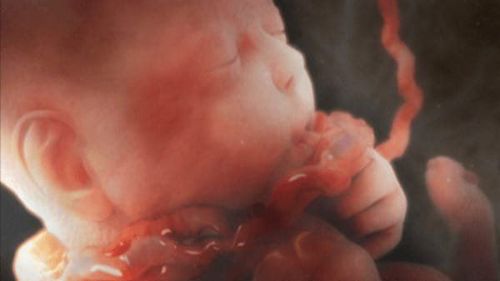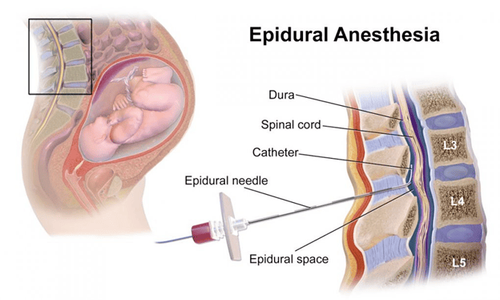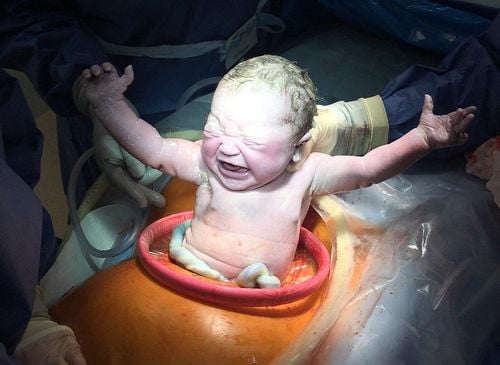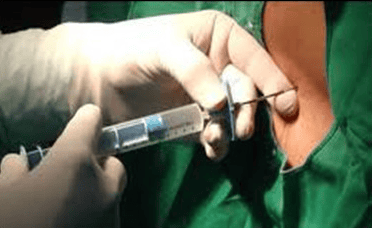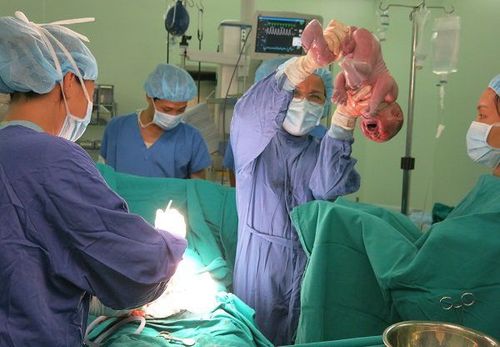This is an automatically translated article.
The article was professionally consulted by an Anesthesiologist - General Surgery Department - Vinmec Nha Trang International General Hospital.Most women with severe preeclampsia are encouraged to have a cesarean delivery because of the risk of preterm delivery and difficulty in labor. Epidural anesthesia is one of the most commonly used anesthetic methods in cesarean section in mothers with severe preeclampsia.
1. Cesarean section in a mother with severe preeclampsia
Preeclampsia is a state of high blood pressure in the second half of pregnancy with the presence of protein in the urine, this is one of the pregnancy diseases that can seriously affect the health of the mother and the fetus. . Pregnant women with pre-eclampsia often have symptoms such as headache, middle abdominal pain above the navel or right, blurred vision, chest tightness, shortness of breath, edema, feeling tired,...Pregnant women are at high risk for preeclampsia, often with one of the following characteristics: age 40 or older; a family history of preeclampsia or a personal history of preeclampsia; had high blood pressure before pregnancy; have some other medical diseases such as diabetes, chronic kidney disease, antiphospholipid syndrome, lupus erythematosus,...
Severe pre-eclampsia will affect organs in the mother's body such as the heart, liver, kidney, lung. If eclampsia occurs, it will seriously affect the mother's brain. Preeclampsia also reduces the amount of blood to the fetus, causing the fetus to be malnourished, the amount of amniotic fluid decreases, the fetus is at risk of stillbirth. Therefore, pregnant women need periodic antenatal check-ups to detect pre-eclampsia early. When being diagnosed by a doctor, pregnant women need to strictly follow the doctor's instructions, use drugs, adjust their lifestyle, have an appropriate diet, and follow-up appointments according to the appointment.
If the pregnancy has progressed to 35-36 weeks and the mother's cervix has softened, it is still possible to give birth naturally. However, the majority of women with severe preeclampsia are often encouraged to have a cesarean section because of the risk of preterm delivery and difficulty in labor. Epidural anesthesia is performed by injecting anesthetic into the epidural space to temporarily inhibit nerve conduction through the spinal cord. This is one of the anesthetic methods used in cesarean section in mothers with severe preeclampsia.
2. The technique of epidural anesthesia for cesarean section in a mother with severe preeclampsia

Gây tê ngoài màng cứng có thể được sử dụng là phương pháp vô cảm cho phẫu thuật lấy thai trên người bệnh tiền sản giật nặng
The patient refuses to perform. Patients who are allergic to local anesthetics or have an infection in the needle puncture site. Patients with inadequate circulatory volume, shock, severe coagulopathy, or inadequately discontinuing anticoagulants. Patients with constricted mitral stenosis, constricted aortic valve, increased intracranial pressure. 2.2. Preparation for performing an epidural during a cesarean section in a mother with severe preeclampsia The epidural will be performed by a specialist anesthesiologist. Necessary facilities for the procedure include:
Needle syringe of all sizes, gloves, sterile gauze, pince, antiseptic alcohol, sterile pore towel, epidural kit. The drugs used include: local anesthetics such as lidocaine, bupivacaine, levobupivacaine, ropivacaine, ... can be combined with drugs of the morphine family, adrenaline, clonidine,... The specific dose will be calculated by the doctor. calculated based on the patient's weight, height and physical condition. In addition, to ensure safety during epidural and surgical anesthesia, necessary emergency and monitoring facilities include:
Oxygen source, Ambu balloon, mask, endotracheal intubation facilities , electric shock machine, anesthesia machine with breathing machine, suction machine,... Routine monitoring of electrocardiographic indicators, blood pressure, oxygen saturation, breathing rate,... Resuscitation drugs including fluids infusion, adrenaline, ephedrine,... Anticonvulsants such as barbituric drugs, benzodiazepines, muscle relaxants, intralipid 20%,... On the patient's side, to prepare for preoperative anesthesia, the doctor will examine before surgery, explain to the patient the purpose of epidural anesthesia so that the patient cooperates when performing. The anesthetic area will be kept clean. In some necessary cases, the doctor will assign the patient to use sedative from the night before surgery.

Người bệnh sẽ được giải thích cặn kẽ về mục đích của việc gây tê ngoài màng cứng
Sitting position: the patient sits with his back bent, head bowed, chin resting on chest, legs stretched on the operating table or feet resting on a chair. Lying position: the patient lies on his side, with his back arched, knees close to his stomach, chin resting on his chest. Steps to administer epidural anesthesia in cesarean section in mothers with severe preeclampsia:
Anesthesiologist wears a hat, mask, washes hands, wears sterile clothes and gloves. Disinfect the puncture site three times with an antiseptic solution, then cover with a sterile tissue. Apply local anesthesia with Lidocaine 1-2%. Midline or lateral anesthesia can be selected. If the anesthetic is in the midline, the doctor will insert the needle into the space between the two posterior spines, the location of the puncture will depend on the high or low surgery. If anesthesia is applied to the lateral line, proceed to insert the needle 1-2cm from the midline, directing the needle in the middle, up, and forward. The doctor identifies the epidural space by signs such as loss of resistance, hanging drops, or ultrasound. The needle is in the correct position when resistance is lost, there is no reflux of cerebrospinal fluid and blood. Once the epidural space has been identified, the doctor turns the needle bevel face up, slowly inserting the catheter with a length of 3-6cm in the epidural space. Withdraw needle Tuohy. Then, aspirate and test with 2-3ml of 2% lidocaine mixed with 1/200.000 adrenaline. Secure the catheter with a sterile bandage. The drugs that can be used for epidural anesthesia are: lidocaine 2% 300-500mg; ropivacaine 0.5% 75-125mg; bupivacaine 0.5% 75-125 mg or levobupivacaine 0.5% 75-125 mg. The drugs that can be used in combination are: morphine 3-4mg; fentanyl 50-100mcg; sufentanil 10-20 mcg not to exceed 30 mcg/kg. To relieve pain after cesarean section in a mother with severe preeclampsia, a continuous infusion of one of the following drugs: bupivacaine 0.1 - 0.125 at a rate of 4-6ml/hour; ropivacaine 0.08 - 0.125 rate 4-10ml/hour; levobupivacaine 0.1 - 0.125 rate 4-10ml/hour. Concentrations of combination drugs are: morphine 10-20mcg/ml; fentanyl 1-2mcg/ml; sufentanil 0.5 mcg/ml.
3. Possible complications with epidural anesthesia for complete hysterectomy and how to handle
3.1. Drug-induced complications and managementNew generation anesthetics are quite safe to use, side effects are rare. However, during epidural anesthesia, the team must always closely monitor the patient. If the patient is allergic, anaphylactic shock with anesthetic. The doctor will immediately stop the drug and implement the anti-anaphylactic regimen according to the instructions of the Ministry of Health.
In case the patient is poisoned by anesthetic due to mistaken injection into the blood vessel. The doctor will immediately stop the drug, perform respiratory and circulatory resuscitation, anticonvulsant, use a 20% Lipid emulsion solution to neutralize the toxicity of the anesthetic.
3.2. Complications due to epidural technique and management
Epidural Perforation: If this is the case, the anesthesiologist will withdraw the needle and change the puncture site (on the old site) or switch to another anesthetic method. . General spinal anesthesia by injecting anesthetic into the subarachnoid space: the anesthesia and surgical team will actively provide respiratory and circulatory resuscitation for the patient. Patients with low blood pressure, slow pulse: The doctor will treat with vasoconstrictor drugs (such as adrenaline, ephedrine, ...), atropin and fluid replacement. Patients with headache: let the patient rest in place, use pain relievers, replace enough fluids, patch the dura with autologous blood (Blood patch). Patients with nausea and vomiting: control blood pressure and use antiemetics for patients. Patients with urinary retention: apply warm compresses and catheterize the patient's bladder if necessary.

Người bệnh đau đầu là một trong số những tai biến có thể gặp phải
Vinmec International General Hospital with a system of modern facilities, medical equipment and a team of experts and doctors with many years of experience in medical examination and treatment, patients can rest assured to visit. examination and treatment at the Hospital.
Please dial HOTLINE for more information or register for an appointment HERE. Download MyVinmec app to make appointments faster and to manage your bookings easily.




